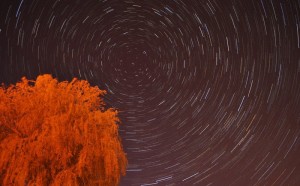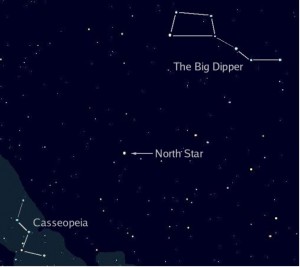Primitive Navigation Learning Objectives
After completing this section you should be able to:
- Find north at night
- Find north using a wrist watch
- Find north using a simple stick shadow method
- Find north using a stick equal shadow method
Find North at Night
Our north star is not a particularly bright star. In fact, it is rather plain and dull. It is not even located directly above our polar north; it is off by a little less than 1 degree. So what’s so special about “Polaris?” Frankly, it comes down to a lack of competition. The north star is an average star that we can see with the naked eye. Its claim to fame is that it happens to be the closest one to being straight above the earths northern pole. So like in real estate, the only three reasons we care about Polaris are location, location and location. We earth fans have a fickled relationship with this star. It has not always been our favorite, the one closest to our pole. And to make matters worse it will be wandering away, hardly demonstrating a long term commitment to the navigational task at hand. But alas, until a better star comes along we are stuck with this rather pathetic uncommitted one.

So what does being Polaris mean? Well, since the earth rotates around our axis, which points pretty close to the north star, it creates the illusion that all the other stars are rotating around the north star, in a counter clockwise manner. Its like we have a giant 24 hour clock in the sky, visible only at night, running backwards, and Polaris is right where the hands appear to have been broken off. Figures.
Throughout the year as we earth-travel around the sun, the stars we can see towards the south change with the seasons. We have winter constellations such as Orion and his famous belt, or in the summer constellations such as Scorpius and Libra. To the north, however, there is a cluster of stars and constellations which are visible to us all year round. They are known as the circumpolar constellations. Our latitude determines how high in the sky Polaris is. There is a giant imaginary circle formed around north star, the radius of which is from Polaris down to our horizon. Any stars or constellations within this circle appear to rotate around Polaris, and yet never dip below the horizon. Because we can always count on them being there, they make great navigational companions.
For most of us in North America, the two most famous circumpolar constellations are Ursa Major (the big dipper) and Ursa Minor (the little dipper). Ursa Major is deserving of the title. Its stars are very bright and easy to pick out, even in urban areas. The little dipper, however, is another story entirely. To give you an idea how dull and boring the little dipper is, just remember the north star is actually the little dippers brightest star and it lives at the far end of the handle. In urban areas even when you can find the north star, you probably won’t be able to make out the rest of the little dipper.

Finding the big dipper is key to finding the North Star. Because of its apparent rotation, it may be right side up, it may be upside down, it may be sideways… but it is always visible, and the two stars furthest away from the handle always point towards the north star. They are called the pointer stars.
On the opposite side of Polaris from the big dipper is another important circumpolar constellation, Cassiopeia. As Cassiopeia rotates around the north star, it appears as a giant slightly lopsided W, or E, or M, or 3. Because Cassiopeia and the Big Dipper are opposites relative to Polaris, if one is up, the other is down, if one is right, the other is left. Knowing this can help you find the north star more quickly.
Find North Using a Wrist Watch
With cell phones, PDAs and smart phones, not many people still wear an analog wrist watch. Without one you can still make method work, as long as you can correctly image a wrist watch, and you know the correct time. Hold the watch level to the ground (like a compass). Assuming standard time, and not day-light savings time, point the hour hand of your watch towards the sun. Some people put a tiny stick at the tip of the hour hand so the sun will cast a shadow, making orientation easier. Notice (or image) where 12 O’clock is on your watch. If you split the angle in half between your present hour hand position and 12 noon, the imaginary line should point south.
Find North Using a Simple Stick Shadow Method
Push a stick into the ground such that the stick does not cast a shadow. No, that does not mean move it into the shade. It means angle it so the stick is pointing directly at the sun. As the earth rotates, the sun will eventually cast a shadow. Wait for the shadow to be about 6 inches long. The direction of the shadow from this stick is relatively east. This is not a precise method, but it is generally true. From experience I will tell you that by the time the shadow should be ready to read, it is possible that the stick will no longer be in the sun. It may be in the shadow of a tree, a hill, an outcropping, or whatever. Because these sticks you are finding on the ground are relatively inexpensive and plentiful, place several of them in various locations, increasing your odds that when you want to read the results, at least one of them is in the sun casting this 6 in long shadow.
Find North Using a Stick Equal Shadow Method
There is a slightly more accurate, though perhaps completely impractical, alternative stick/shadow method. It involves putting a stick in the ground in the morning. Using a string with a loop in the end, marking a complete circle around the stick whose radius is equal to the length of the shadow. Pound a small peg into the intersection point between the tip of the shadow and the circle. Now, get this, wait until the afternoon when the shadow has intersected with another point on the circle, and pound in a new peg. Frankly, how much time do these people think we have? By this time Tom Hanks would have painted a face on a coconut and named him Wilson. He may have even whittled an analog watch. At any rate, by drawing a line between the two equal distance intersect points, you have established the west-east line. Another line from the center stick perpendicular to the west-east line is north-south.
Primitive Directions Review
You should be able to:
- Find north at night
- Find north using a wrist watch
- Find north using a simple stick shadow method
- Find north using a stick equal shadow method
